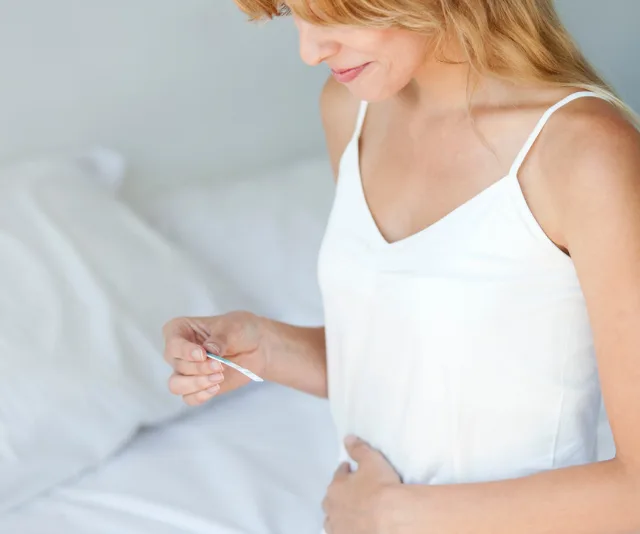Congratulations! You may not even realise it yet, but you’re pregnant. Pregnancy is actually dated from the first day of your last period, so conception is said to happen in week 3.
Although you won’t yet have any external signs, internally your body is already hard at work, preparing for the next nine months …
What’s happening to your uterus
Your uterus normally weighs about 60g and is 7.5cm long. But as soon as conception occurs, increased quantities of the female sex hormone oestrogen start to make your uterus grow in weight and size. The lining thickens to form a deep, juicy layer, in which the embryo can implant, and new muscle fibres already begin to form in preparation for the great muscular effort of giving birth.
What’s happening to your cervix
Your cervix (the neck of the uterus) increases slightly in width, becomes softer and deepens in colour due to the increased blood supply and the effects of the hormone oestrogen. Glands in the cervix form a thick mucus plug that seals off the uterus and protects your growing baby from infection.
No more periods!
You’ve already had your last period for the next few months! As soon as the embryo implants, chemical messengers tell your body that you’re pregnant and halt your menstrual cycle. However, you may experience some ‘spotting’ as the embryo attaches itself to the wall of your uterus.

Although you won’t yet have any external signs, internally your body is already hard at work.
Your baby
The fact that you’re pregnant is a small miracle in itself and amazing feats have already occurred to enable you to conceive …
Let’s get fertilised
At ovulation – around the middle of your cycle – an egg about 0.2mm wide floats down one of your Fallopian tubes. Rushing to meet it are around 300 million sperm (swimming along at speeds of 1 to 4mm a minute), which have to survive the acidity of your vagina, swim through a barrier of mucus and race against each other before finally finding the egg.
Some sperm manage this entire journey in just 45 minutes, although others take up to 24 hours. Of the sperm that get this far, only one will actually penetrate your egg’s thick outer layer and breach the inner membrane. As it does so, the head of the sperm separates from the tail and the chromosomes of the sperm’s nucleus merge with the nucleus of the egg to form a two-cell structure about 0.2mm wide.
Hello embryo!
Once the sperm has penetrated your egg and fertilisation occurs, the fertilised egg (now known as a zygote) takes 4-5 days to travel down the Fallopian tube. It is dividing repeatedly into a cluster of cells called the blastocyst. After seven days it implants itself in the uterus wall and begins to produce the pregnancy hormone human chorionic gonadotrophin (HCG) and is now an embryo. On the outer cells of the embryo, fronds known as villi burrow into the uterus lining and form the beginnings of the placenta, umbilical cord and membranes.

You’ve already had your last period for the next few months!
Super cells
The inner cells of the embryo are forming three layers of tissue. Although all these cells are identical, the outer layer develops into the skin, eyes, nervous system, mammary and other glands. The middle layer develops into muscle, bones, connective tissues, blood vessels, urinary and reproductive organs. And the inner layer develops into glands and internal organs such as the liver, spleen, lungs and digestive canal.
What does your embryo look like?
The cells of your developing embryo are rapidly dividing as it grows, but by day 17 is still only just visible to the naked eye and looks more like a translucent larva than a human! But it already has a head, a tail (which is the end of the spinal cord) and buds that will later form limbs. Its tiny heart has already taken its first erratic beat. The placenta, which provides support for your baby by providing it with nutrients and eliminating waste products, is also starting to form.
By about day 27 your embryo is rapidly growing at around 1mm a day and is now about 0.5cm long. Its head is still larger than the body and features are slowly becoming more pronounced. Its heart is dividing into two chambers (later four), and starts beating more regularly. The limb buds that will form separate shoulders, arms and hands are growing, as are the thighs, legs and feet. By day 34, tiny (and at this stage webbed) fingers are growing.
Keeping afloat
Amniotic fluid, which helps to protect your baby, is forming. Amniotic fluid is a warm fluid that is about 99% water and is a salt solution. As well as cushioning your growing baby, it allows it to move more freely. The reason it is a salt solution is because our ancestors evolved from the sea!
You’ve got twins!
About one in 80 pregnancies are twins and you’ve got more chance of having twins if you already have them in your family.
Fraternal (non-identical) twins form when two sperm fertilise two eggs released at the same time. These babies have different genes, separate placentas and are no more alike than brothers and sisters.
Identical twins begin as a single egg which is fertilised by a single sperm, as usual, but in the early stages of cell division splits completely in half, forming two separate, but identical, human beings. They may share the same placenta, unless the division happened while still in the Fallopian tube, when they may develop separate ones.
When one disappears – Sometimes an early scan shows two embryos, but later on in pregnancy, one disappears. The second twin seems to be naturally reabsorbed into the uterus.

-scaled.jpg?resize=380%2C285)
.png?resize=380%2C285)